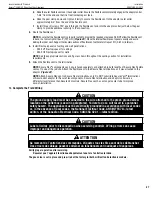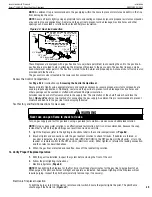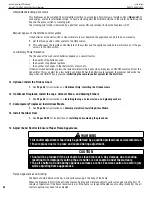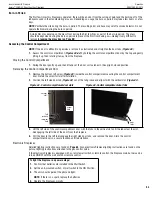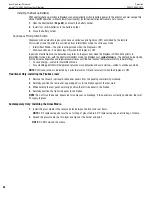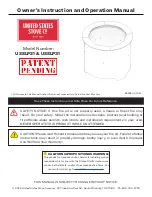
Installation
900475-00, 08/2015
Innovative Hearth Products
Aurora™ 35/40/45 Direct-Vent Gas Fireplaces
39
NOTE:
A sediment trap is recommended in the gas piping within the home to prevent moisture and debris in the line
from damaging the valve.
NOTE:
Secure all joints tightly using appropriate tools and sealing compounds (ensure propane resistant compounds
are used in propane applications). Seal around the gas line to prevent cold air leakage. Gas line holes and other
openings can be caulked or stuffed with unfaced fiberglass insulation.
Figure 32 - Gas Line Connection
(Optional) flexible gas
line connector
Gas
valve
3/8” Nipple
3/8” Union
3/8” Close nipple
3/8” Shutoff valve
3/8 NPT x 3/8”
Flare fitting
1/2 x 3/8” Flare
shutoff valve
3/8” Flex tubing
Gas
stub
1/2 x 3/8”
Reducer
These fireplaces are equipped with a gas flex line for use (where permitted) in connecting the unit to the gas line. A
gas flex line is provided to aid in attaching the direct-vent fireplace to the gas supply. The gas flex line can only be
used where local codes permit. The flex line is rated for both natural and propane gas. A manual shut off valve is also
provided with the flex line.
The gas control valve is located in the lower control compartment.
Access the Control Compartment
See
Page 53
for instructions on
Accessing the Control Compartment
.
Secure all joints tightly using appropriate tools and sealing compounds (ensure propane resistant compounds are
used in propane applications). Optionally, seal around the gas line to prevent cold air leakage. Gas line holes and
other openings can be caulked or stuffed with unfaced fiberglass insulation.
All codes require a shutoff valve mounted in the supply line. The orientation of the shutoff valve should face the
front.
Figure 32
illustrates two methods for connecting the gas supply. A sediment trap is recommended to prevent
moisture and debris in the gas line from damaging the valve.
Test Factory and Field Connections for Gas Leaks
WARNING
Never use an open flame to check for leaks.
Turn on gas supply and test for gas leaks, using a gas leak test solution—also known as bubble leak solution.
NOTE:
Using a soapy water solution is an effective leak test solution but it is not recommended, because the soap
residue that is left on the pipes/fittings can result in corrosion over time.
1.
Light the fireplace (refer to the lighting instructions label in the control compartment or
Page 64
).
2.
Brush all joints and connections with the gas leak test solution to check for leaks. If bubbles are formed, or
gas odor is detected, turn the gas control knob (OFF/PILOT/ON) to the OFF position (millivolt units), or turn the
receiver or remote control to the OFF position (electronic units). Either tighten or refasten the leaking connection,
and then retest as described above.
3.
When the gas lines are tested and leak free, rinse off the leak testing solution
14.
Verify Proper Fireplace Operation
1.
With the gas line installed, inspect the system before closing the front of the unit.
2.
Follow the pilot lighting instructions:
•
Electronic Systems (
Page 64
)
NOTE:
When lighting the fireplace for the first time, it will take a few minutes for the gas line to purge itself of air.
When purged, the pilot and burner will light and operate as indicated. Subsequent lighting of the fireplace will not
require purging. Inspect the pilot flame (carefully remove logs, if necessary).
Electronic Fireplace Inspection
To light the burner, turn ON the wall or remote control switch. Ensure the igniter lights the pilot. The pilot flame
should engulf the flame rod (
Figure 33
).













